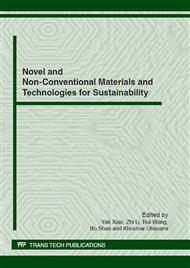p.646
p.653
p.661
p.669
p.677
p.683
p.689
p.695
p.705
The Effect of Knots on Bending Modulus of Elasticity of Dimension Lumber
Abstract:
The defects, especially for knot, seriously affect the bending properties of wood. In this paper, full scale specimens and clear specimens for bending test, cut from dimension lumbers of Larix gmelinii with different kinds of knots, aimed to predictive accuracy of the modulus of elasticity (MOE) in bending and to improve the accuracy of MOE by multivariate regression analysis with density and knot information. According to the regression analysis results, the [(IK/Ig)·(MK/Mo)] of all knots and the average density ρa showed the best predictive accuracy of MOE for full scale specimen (Efull), with 0.674 of R2 and 1.15 of RMSE. Based on the ratio of regression parameter B/A of independent variables for density and knots information, the knots had less influential than density on influencing Efull. Finally, a simplified theoretical model that can be used to calculate MOE for dimension lumber, was defined as Efull/Eclear = B[(IK/Ig)·(MK/Mo)]+C .
Info:
Periodical:
Pages:
677-682
Citation:
Online since:
June 2012
Authors:
Keywords:
Price:
Сopyright:
© 2012 Trans Tech Publications Ltd. All Rights Reserved
Share:
Citation:


